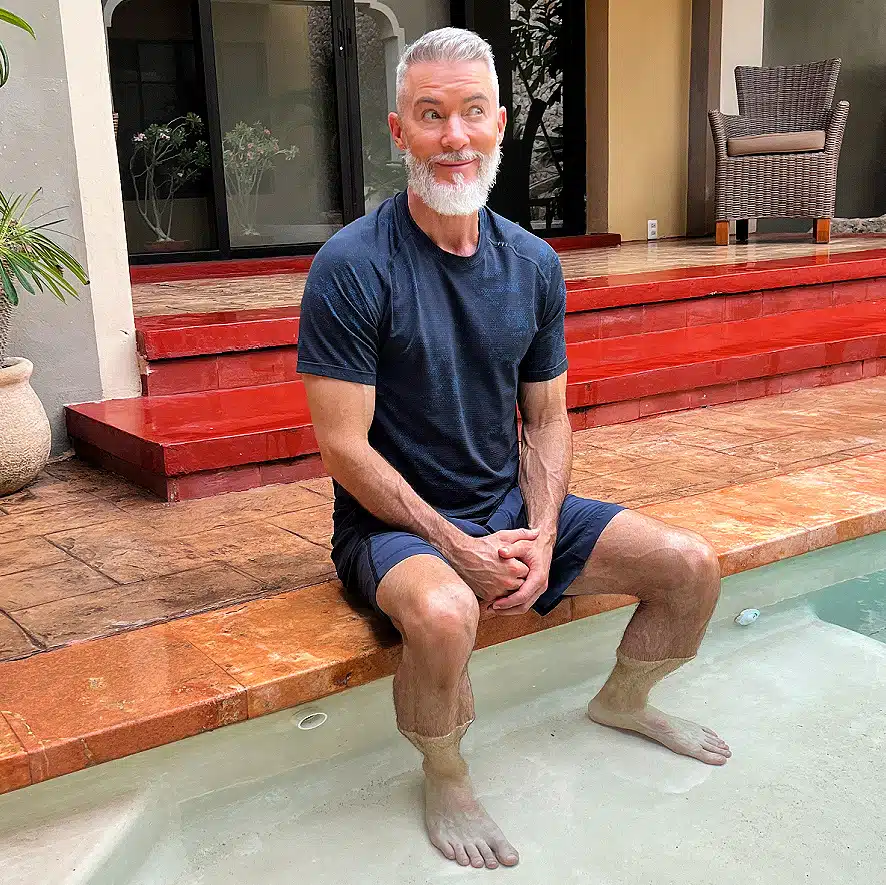One of the biggest fitness mistakes older adults make is not doing a proper warm-up before their workout. Lower within this article, you’ll find a video of helpful warm-up exercises for seniors that can be done before each workout.
Preparing your body for exercise during midlife and beyond is essential to avoid injury and prevent postural imbalances.
Additionally, the better the warm-up, the better the workout – which means positive results and a better return on your time and energy investment.
The warm-up included here is not just good for seniors but anyone over the age of 50:
- For seniors experiencing stiffness or joint or back discomfort, I encourage you to do these warm-up exercises at a very slow pace.
- For those in middle age who are in good health and pain-free, you can do this warm-up faster.
Prioritizing Joint Mobility, Aligned Posture, and Muscular Flexibility for Seniors
Many seniors seen in sports medicine clinics are there because of skeletal muscle injuries, joint injuries, or misalignment of the lower-back vertebrae – all injuries that often can be prevented by proper preparation before a workout.
Physical therapists have established that a good warm-up oxygenates your heart so it can prepare to perform at a higher rate of intensity.
The same happens with the other body muscles – warm blood and oxygen are circulated into the muscles, raising your body temperature gradually.
Whether you do resistance training at the gym, play tennis, jog, or golf, it’s benefited from a good warm-up.
A supple senior enjoys mobile joints, attractive posture, and flexible muscles. A good warm-up can help achieve these benefits.
“Heat warms the muscles and further prepares them for physical activity. Warm muscles function more safely and efficiently in general; they contract more forcefully, have more elasticity, and are less susceptible to being strained or pulled.”
– Biokinetix
Static VS Ballistic: Knowing the Best Type of Warm-Up
For seniors, a small warm-up can have a big impact:
- Static stretching (creating a deep stretch in a muscle and holding it for at least 30 seconds) is usually best saved for your post-workout cool-down. This will help reduce day-after muscle soreness.
- Ballistic stretching – consisting of slow, gentle, and rhythmic movements – is what belongs in a warm-up for seniors.

Joint Health for Seniors: Releasing Synovial Fluid During a Warm-Up
Joints are covered by tissue called the synovial membrane.
This means that, ultimately, joints release something called synovial fluid during your warm-up. It’s a solution that lubricates your joints and lowers the risk of injury and stress on tendons and ligaments.
According to medical doctor John Haselow, “As synovial fluid is secreted and becomes less viscous, friction at the joint is greatly reduced. Synovial fluid also serves as a transport medium to provide nutrients to the articulating cartilage and to remove waste.”
Starting Standing Position
Begin this dynamic warm-up with your feet shoulder-width apart:
- First, be mindful of your lower body. Your feet should distribute your body weight evenly across the soles of your feet – instead of supporting weight on just one side of the foot – and your knees should be slightly soft (not locked).
- Your pelvis should be centered – not arching back or scooped too far forward.
- Next, check in with your upper body. Your navel should be pulled in a bit, and your spine should be tall. Press your shoulders down away from your ears and glide them back a little.
- Finally, your neck should be long.
Moves:
- Soft head rolls (in each direction).
- Look right and left.
- Chin tucks.
- Side neck stretch.
- Shoulder rolls.
- Clock (single arm circles).
- Hand circles for wrists.
- Forearm circles for elbows.
- Arm shake.
- Doorknob twists with “T” arms.
- Spine rotations.
- Vacuum and overhead stretch (alternating).
- Ragdoll* and spine roll-ups (alternating).
- Knee circles for hip (each direction).
- Leg shake.
- Leg rocker (forward and back).
- Ankle circles (each direction).
- Point-and-flex.
*skip any warm-up exercises that cause discomfort to your lower back.
“A side benefit of warming up is that your brain will become focused on your body and your physical activity as you go through the process. This focus will carry over into your training session to help you improve your technique, coordination, and skill.”
– Tri-City medical center
Warm-Up Precautions for Seniors
The warm-up is your opportunity to see how your body operates on any given day. If there’s an issue, you want to discover it during the warm-up and not the workout.
Proceed gingerly.
The neck, shoulders, hips, lower back, and knees can sometimes get stiff or tender – especially in seniors.
If these areas are utilized too intensely too soon, they can injure. Begin your preparation slowly and think of it as an exploration. Your warm-up is your diagnostic scan.
When you do arm or leg shakes, be sure there is nothing nearby – a person, a wall, or furniture – that you could hit.
What You Need to Know about Your Warm-Up (Conclusion)
One of the standard fitness mistakes seniors make is neglecting to prepare their bodies sufficiently for an impending workout.
The idea behind a warm-up is to gradually raise your body temperature – so that your muscles are less cold and more pliable – and to lubricate your joints so that you can prevent injury as you put your physique under increasingly stressful loads:
- For athletes in their 20s, warming up is still a good idea – though a ten-minute warm-up might be all that’s required to prepare a young body for a strenuous workout.
- Warming up is a higher priority for athletes in their 30s and above.
- For people over the age of 50, it is imperative.
- For seniors, this warm-up make can make an effective low-impact exercise routine, depending on how much time the exerciser has and their current fitness level.

Intelligent preparation before a workout helps to prevent injury and imbalances. The warm-up exercises for seniors included here can make all the difference.
By the way, an excellent post-workout cool-down can also be very helpful.
Seniors should get the go-ahead from their doctor before making any significant changes to their health habits.
Additional Sources for Seniors:
Kinetix – https://biokinetix.com/wp-content/uploads/2016/09/Warm-Up-Difference-by-BIOKINETIX.pdf
Tri-City Medical Center – https://www.tricitymed.org/2016/12/warming-cooling-important/
Supplements that Might Improve Functionality in Older Adults – https://examine.com/topics/functionality-in-elderly-or-injured/
